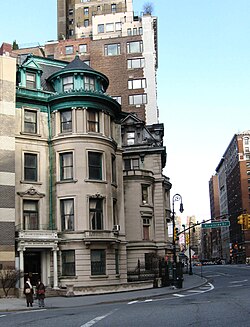 1 Riverside Drive at 72nd Street, (C.P.H. Gilbert, architect, now a satellite location for the Islamic Cultural Center of New York) | |
| Namesake | Hudson River |
|---|---|
| Owner | City of New York |
| Maintained by | NYCDOT |
| Location | Manhattan, New York City |
| South end | 72nd Street in Upper West Side |
| North end | 181st Street in Washington Heights Dyckman Street in Inwood (disconnected segment) |
| East | West End Avenue (72nd–107th Sts) Broadway (107th–116th, 127–159th Sts) Claremont Avenue (116th–127th Sts (Tiemann Pl)) Fort Washington Avenue (159th–168th Sts) Haven Avenue (168th–181st Sts) |
| West | Henry Hudson Parkway |
| Construction | |
| Commissioned | 1868 |
| Construction start | 1872 |
| Completion | 1880 (original section), 1928 (final extension) |
Riverside Drive is a north–south avenue in the New York City borough of Manhattan. The road runs on the west side of Upper Manhattan, generally paralleling the Hudson River and Riverside Park between 72nd Street and the vicinity of the George Washington Bridge at 181st Street. North of 96th Street, Riverside Drive is a wide divided roadway. At several locations, a serpentine service road diverges from the main road, providing access to the residential buildings. Several viaducts connect the various segments of Riverside Drive, including the 2,047-foot (624 m) Manhattan Valley Viaduct between Tiemann Place and 135th Street. A disconnected section of Riverside Drive exists in Inwood, Manhattan. The New York City Landmarks Preservation Commission has designated the original section of Riverside Drive, between 72nd and 125th streets, as part of a scenic landmark that also includes Riverside Park.
Riverside Drive was proposed as part of Riverside Park, which was established by land condemnation in 1872. Originally known as Riverside Avenue, the road opened in 1880 and originally ran between 72nd Street and the current site of Grant's Tomb. The park and avenue were originally designed by architects and horticulturalists such as Calvert Vaux and Samuel Parsons. Riverside Drive was extended north to 155th Street in the 1900s, and a viaduct carrying Riverside Drive West between 155th and 161st streets was built in the 1920s. Traffic flow on Riverside Drive was modified several times throughout the years, and the viaducts have been renovated as well. A southern extension, known as Riverside Boulevard, was built starting in the 1990s when the Riverside South complex was developed.
Between 72nd and 125th streets, nearly every block of Riverside Drive is part of a New York City historic district, and the buildings on these blocks date from before World War II. The eastern side of Riverside Drive originally included luxuriously finished rowhouses interspersed with free-standing mansions, though few of the mansions remain. Many of Riverside Drive's apartment buildings date from between the 1900s and the 1930s, with curving facades along the avenue; some of these buildings are designated as city landmarks. Along Riverside Drive, there are also numerous monuments such as Grant's Tomb and the Soldiers' and Sailors' Monument, in addition to other structures such as Riverside Church. Riverside Drive has received commentary for its landscape features and architecture, and it has been depicted in works of popular media.